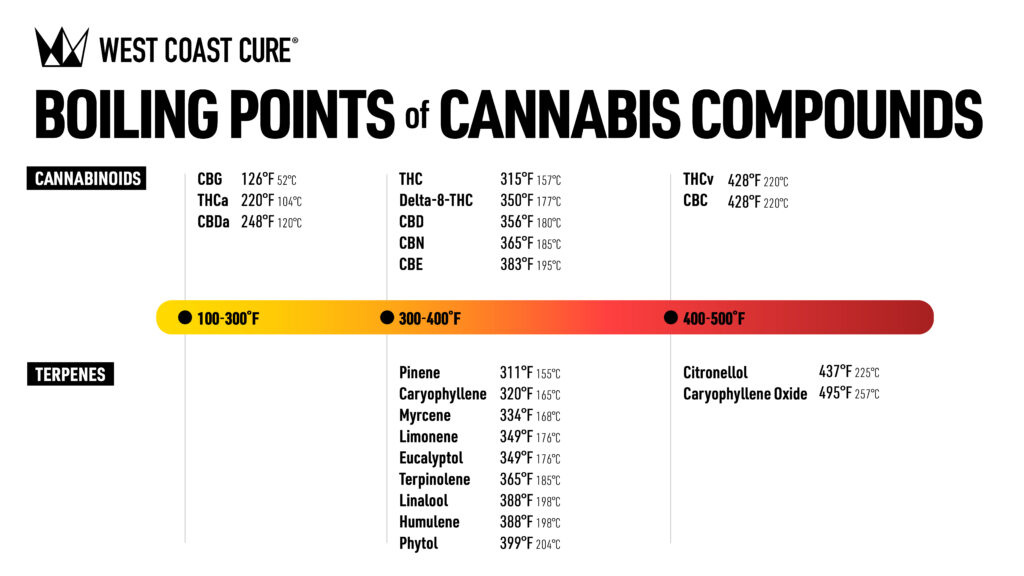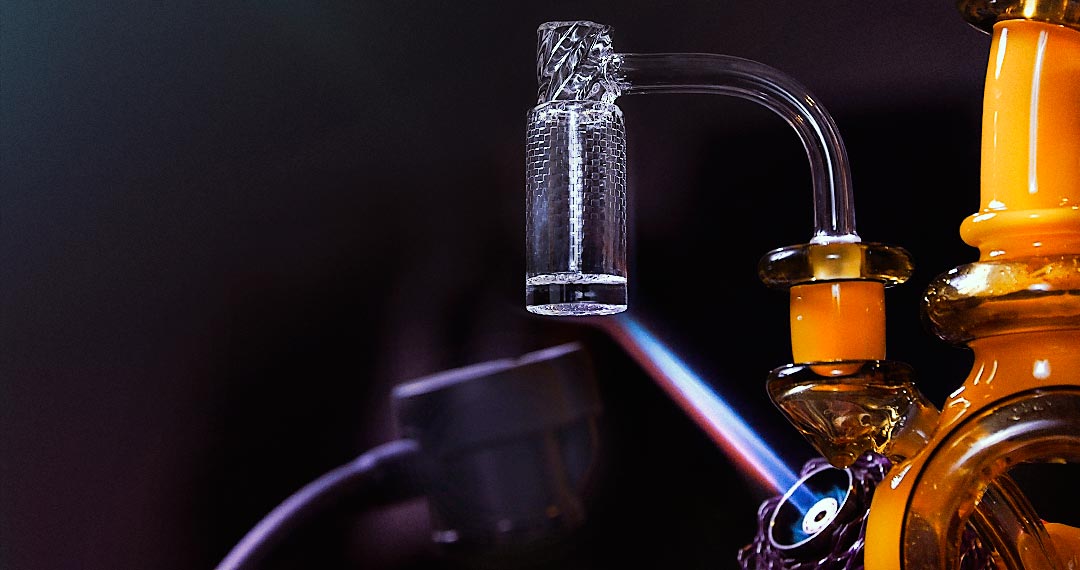For real heads and hip newcomers alike, dabbing represents the ultimate high. Every mode of consumption offers a unique, worthwhile shade of the cannabis experience (as long as it’s a quality product, of course), but nothing hits quite like dropping a silky dab of premium extract in your rig at the perfect dab temperature, molecular goodness of the plant in a clean, flavorful vapor. And though dab technology has come a long way in a relatively short time, the barrier to entry for dabbing can be steep, even if it ain’t your first rodeo.
But mastering the art of the dab isn’t as complicated as it looks, especially when you know temperature control is the critical factor.
So what’s the optimal dab temperature? The question has entered the mind of anyone who’s ever heated up an e-nail or taken a torch to a quartz or glass banger. Dabbing requires a unique set of equipment (and a quality weed product) to “get it right.” And like anything worth experiencing, no one size fits all. For every dab setup and concentrate, there’s a pitch-perfect temperature that’ll unlock the full dankness. To help you get there, here’s the West Coast Cure guide to dab temperatures: how dabbing works, the range of temperatures at which cannabis compounds will give up the ghost, and which products you should reach for to get closer to the perfect dab.
What’s the Best Dab Temperature?
At its core, achieving the perfect dab is about melting the concentrate thoroughly without burning it completely. It’s a delicate dance with no one-size-fits-all solution. Moreover, there isn’t one absolute best dab temperature for every dab. Your ideal dab will depend on the chemical makeup of the concentrate in your nail. But don’t worry, it’s not a total guessing game. There’s a definite range of temperatures that lead to a good dab: between 400 and 650°F (204-343°C).
Now, let’s break that range down a bit further into low, medium, and high-temp dabs to give you a better sense of the different experiences you’re likely to get within the safe zone:
400-450°F (204–232°C): A low-temp dab. Your best chance at vaporizing terpenes without burning them, delivering a full-spectrum high and the best possible flavor.
450-550°F (232-287°C): A medium-temp dab. You’ll likely experience a lower flavor profile with thicker clouds and a bolder psychoactive rush upon inhale.
600-650°F (315-343°C): A high-temp dab. Your concentrate may combust quickly and produce thick, smoky clouds. Many unique flavors will be lost as the terpenes will be burnt off.
Go below 350°F and you risk wasting your concentrate by not fully vaporizing it. But once you hit above 650°F, you’re really in a bad spot. Going that high or higher results in harsh or straight-up burnt dabs. Cannabinoids, terpenes, and flavonoids are volatile compounds that break down into carcinogens under such extreme temperatures. Best to avoid them and stay below 600°F minimum. The more we come to know about cannabis, the clearer it is that a low-temp dab at around 450°F is your best bet at getting the most out of a quality concentrate.
Cannabinoids, Terpenes, and Boiling Points
So why go so low when it comes to dab temperatures? What makes dabbing such a unique, worthwhile experience is also what makes it a tricky one to master. Every cannabinoid and terpene has a unique activation and boiling point. The primary psychoactive compounds in cannabis, such as THC, have specific activation temperatures that make them available to your body’s endocannabinoid system, unlocking the effects for which they’re known. For instance, THCa has an activation temperature of 220°F, which is when it converts to THC and becomes psychoactive. It also has a boiling point of 315°F. Go past the boiling point and you risk burning off THC and sacrificing potency.
Terpenes also have different boiling points, with some like Pinene boiling at 311°F Fahrenheit and others, like Linalool boiling at 388°F. Other prominent and frequently sought-after terpenes and their corresponding boiling points include:
- Myrcene: 334°F / 168°C
- Limonene: 349°F / 176°C
- Humulene: 388°F / 198°C
- Terpineol: 426.2°F / 219°C
- Phytol: 399°F / 204°C
- Citronellol: 437°F / 225°C
Full spectrum is a critical concept in cannabis, meaning whatever molecular structure the original plant had, the extraction will have the same ratio of cannabinoids, terpenes, and flavonoids. At West Coast Cure, we set out to get the plant exactly as it was at harvest on a molecular level because we know the fullness of a cultivar’s cannabinoid and terpene profile is the only thing that can deliver a well-rounded, pure cannabis feeling and flavor. The key to unlocking that experience in a dab is hitting a temperature that activates cannabinoids without burning off your concentrate’s predominant terpenes.
Temperature Guide/Chart
Finding the right temperature is crucial for optimal flavor and effects from your dab. Check out this chart for guidance on the temperature range necessary to activate common terpenes and cannabinoids.

- Low-temp Range 400-450°F / 204–232°C
- Mid-temp Range 450-600°F / 232-315°C
- High-temp Range 600-650°F / 315-343°C
Dab Rig vs. E-Nail vs. E-Rig
Dabbing has come a long way since the days of “hot knifing” — heating a concentrate over a stove between two hot knives and inhaling the resulting vapor in the open air. Just a few decades and a wave of cannabis legalization later, dabbing has moved even beyond the modern dab rig and butane torch setup to e-rigs, e-nails, and portable dab pens.
So which is best for hitting your optimal dab temperature? The answer isn’t as straight-fowrard as you might think, though there’s obviously something to be said for newer devices that offer more precise temperature control and less guesswork.
Dab Rig
Using a traditional glass rig and heating the concentrate in a nail (or banger) with the open flame of a torch is still the preferred method for many seasoned dabbers. In addition to the functional art element that appeals to heady glass collectors, a standard glass rig can offer a more even dab since concentrate is dabbed after the nail is sufficiently heated, rather than pre-loaded before heating begins. Depending on your dedication to knowing your rig’s functional ins and outs, it can also offer more freedom to modify your experience to your exact preferences.
Unfortunately, getting the right temperature is more of a trial-and-error process with the traditional rig setup. You have to get a feel for your piece and get a sense of how long it takes your nail to heat up over time (though with most nails it takes between 30 and 60 seconds after you’ve sufficiently torched it to achieve a suitable dab temp). There’s also the potential danger of working with a torch’s open flame to consider, as well as the need for butane refills.
If you go the old torch-and-banger route, be sure to use a dab temp reader, a digital thermometer explicitly designed to read the temperature of a dab nail. Some temp readers use gauge temperature with a laser, while others you can place right against the nail for an accurate temp.
E-Nail
An e-nail is an electronic dabbing device that regulates the temperature of the nail for a more consistent smoking experience than a traditional torch and banger setup. Similar to an electronic rig, which we’ll get to soon, replacing your rig’s nail with an e-nail means you can set the same temperature over and over again, honing in on and maintaining the optimal conditions for your concentrate.
E-Rig
An e-rig is a device that heats an attached atomizer with a battery and can be either portable or tabletop. It allows the dabber to set the temperature down to the exact degree, giving them the option to choose low temps for more flavor or higher (but not too high!) temps for big clouds. Once you find the temperature you prefer, you can quickly heat your device to that temperature repeatedly.
Price can be a drawback when shopping for quality e-rigs and e-nails. Most require a significant upfront investment, and each e-rig or e-nail brand offers its own unique design and approach to the technology. So knowing which device is best for you can be an uphill climb. But if you’re dabbing on the reg, or even semi-often, temperature consistency makes it a worthwhile investment.
Cleaning e-rigs and e-nails can also be a challenge. Due to their electrical components, e-rigs cannot be soaked in alcohol like a glass rig can. And e-nails usually have multiple pieces that require disassembly, soaking, and reassembly. Cleaning, maintaining, and properly storing and transporting your rig takes time to learn how to get right, but again, the ability to get your dab just right makes the effort absolutely worth it.
How to Low-Temp Dab
Unless you’re a genuine dab wizard, the more precisely you can control the temperature and keep it at the lower end of the dab temp range, the better the experience will be when you finally drop a dab in your rig and toke up. Here’s a quick primer on how to do a low temp dab using a glass rig, e-nail, and e-rig.
Regardless of which device you’re using, the real trick to finding the right dab temp is to refer to the activation and boiling points of the most prominent cannabinoids and terpenes, and land on the optimal temperature that’ll unlock the cultivar’s full flavor and effect. Every major cannabinoid and most of the common terpenes activate and evaporate within the low-temp dab range, so staying around or below 450°F is strongly advised. If you’re using a traditional glass rig, keep a reliable dab thermometer on hand and make sure your banger is heated around 450° before you drop in your dab.
Dab Pens and Vape Carts
Portability can be tricky when it comes to dab rigs, e-rigs, and e-nails. Even the “portable” ones can be cumbersome and fragile, and there’s still the problem of prompt, regular cleaning to deal with in most situations. Dab pens, not to be confused with vape pens, which utilize concentrate vape cartridges, are small portable devices that allow you to vaporize a concentrate straight from the jar without needing a water chamber, nail, or additional dab tools. Most dab pens have ample heat settings so you can still control the temperature as it suits you.
Though vape pens and THC vape cartridges don’t offer what you might consider the “full dab” experience, we’re starting to see more and more cartridges in the market that deliver quality full-spectrum live rosin in vape cart form. A quality rosin cart offers unfettered access to an authentic dab’s full spectrum of flavors and sensations, especially when paired with a vape battery that heats properly. West Coast Cure’s CUREpen Pro Battery offers a low-voltage setting that’s perfect for achieving lower vape temperatures and unlocking the whole, flavorful, dab-like experience of a rosin cart.
Which Concentrate is Best for Dabbing?
While different consistencies of concentrate elicit different shades of vapor and flavor when dabbed, what really makes the difference is the quality of the concentrate and the temperature at which its most prominent cannabinoids and terpenes evaporate. Sauce, Badder, Sugar, Diamonds, Wax, Shatter—if the product is quality and the temp is right, it’s all dank, dabbable goodness baby!
Ultimately, which type of concentrate you reach for is mostly a matter of personal preference. Some may be easier to handle and load into your rig than others. For instance, West Coast Cure’s Live Rosin Cold Cure Badder is set to cure under controlled temperature until it reaches a cake-batter-like consistency. The slightly firmer texture makes it physically easier to dab with virtually any device. But that’s for you to test out and discover. We’re confident we’ve given you the tools and know-how to find the perfect dab temperature for your rig and ensure you get the most out of every concentrate.
